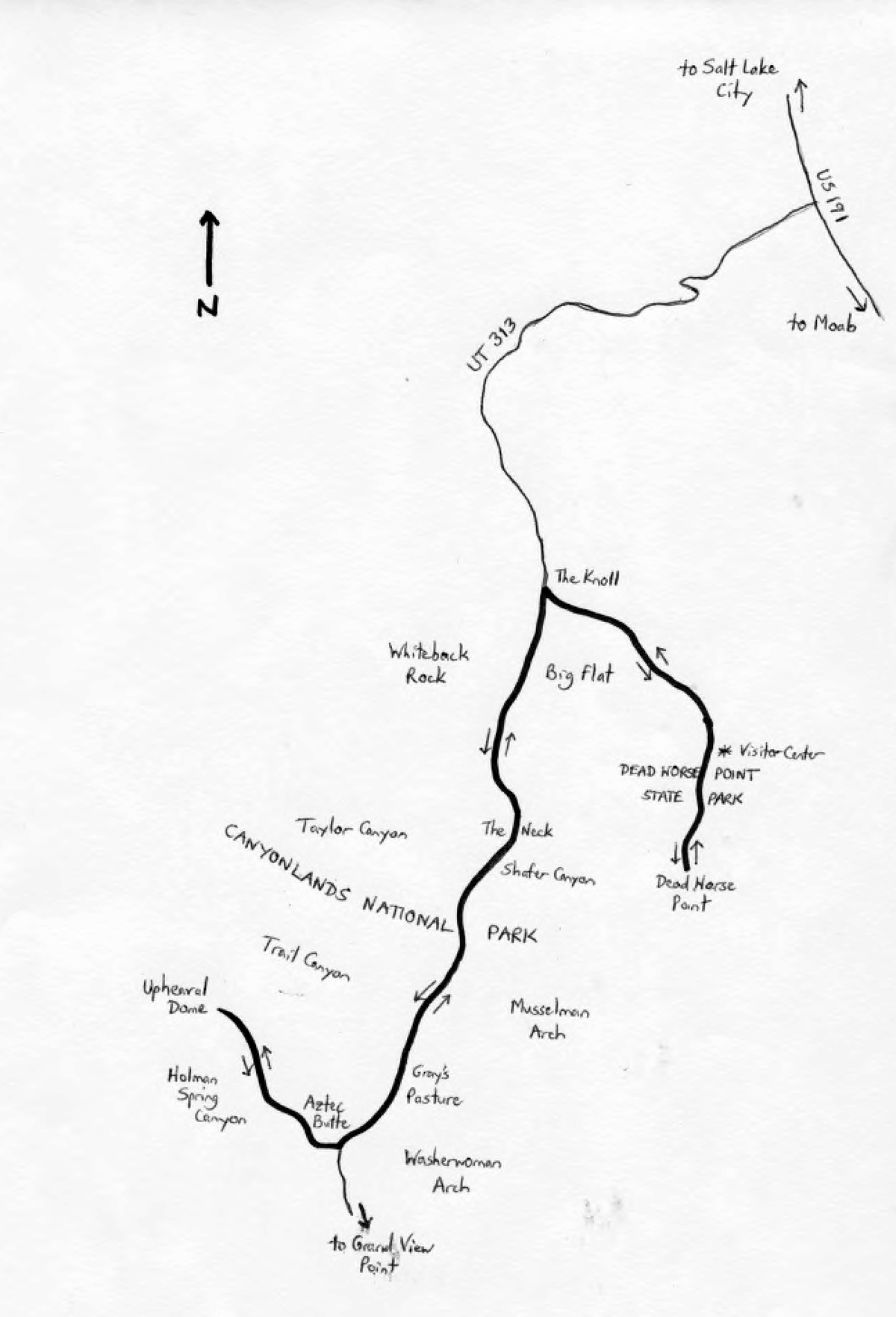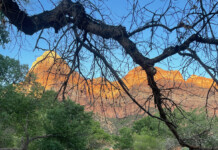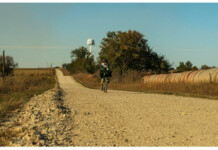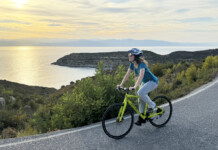The Islands in the Sky Cruise is a 51.0-mile out-and-back ride over undulating terrain between and through Dead Horse Point State Park and Canyonlands National Park, in southeastern Utah. The route passes through and above some of Utah’s most spectacular scenery, within a State and a National Park. Elevations range from 5,639 feet at Upheaval Dome, at the turnaround point in Canyonlands, to 6,184 feet on Big Flat, on Utah Highway (UT) 313 between Dead Horse Point and Canyonlands. The nearest town in Moab, which is 33 miles away from the entrance to Dead Horse Point State Park. (Use routes UT 313 and US 191 to reach Moab). The park-to-park-to-park routing is rare among Utah’s road rides. The relatively small difference between the high and low elevations – just 545 feet – suggests that there are no extended climbs along the way. The terrain undulates, though, making the ride far from flat. It is best to be prepared for this ride by bringing cash or card for park entrance fees. As of this writing, the fees were $15 for motor vehicles to enter Dead Horse Point State Park (to park and start the ride), $5 (proposed to increase to $10) to bicycle into Canyonlands National Park, and then $2 to bicycle into Dead Horse Point (on the return, although this may be waived with a receipt from your earlier entrance). Bring plenty of water, too, as you may not be able to find any for long stretches.

A description of this ride appears in the author’s Road Biking Utah, which was published in 2010. What has changed since then? Well, the roads and scenery are the same. The greatest change has been in the popularity of Canyonlands, which has experienced up to 20% annual increases in attendance. In fact, by 2016, annual park attendance was nearly double that of previous years. The park is divided into three districts, with the Island in the Sky District being the most accessible. While you will most likely not see any motor vehicle queues on the park’s roads, as you might at nearby Arches National Park, you certainly will not be alone, particularly during the peak summer months. Start the ride at the Dead Horse Point State Park’s Visitor Center, located just inside the main entrance. Turn left and head toward Dead Horse Point overlook, which is 1.3 miles away. The park is so-named because cowboys would use the mesa, at the overlook, as a natural corral for their horses. If you peer over the edge of the overlook, you will see the Colorado River winding through the deep canyon, about 2,000 feet below. Although the name suggests that horses leapt to their death from the mesa, it is likely that horses died from exposure to the sun and the associated dryness. While the canyon is not as deep as that of the Grand Canyon, Dead Horse Point’s version actually doubled as the Grand Canyon in the 1991 film Thelma and Louise. Only true experts would know the difference, right?
After spending some time on the overlook, turnaround and head back through the park. After leaving the park, passing its two entrance stations, you are now on UT 313. The Knoll appears on your right as you approach the junction with the main road into Canyonlands (Grandview Point Road; mile 9.2). Turn left here, and head south over Big Flat (highest elevation of the ride). Enter Canyonlands at mile 13.6; the official entrance station is at mile 14.8, where you can pay the fee for bicycles (please see above). The visitor center, with lavatories and vending (water!), is at mile 15.9. Beyond the visitor center, the road crosses The Neck (mile 16.6). As the name implies there are canyons to your left (Shafer) and right (Trail and Taylor). Shafer plunges steeply to the Colorado River, and there is an overlook. Beyond The Knoll is Gray’s Pasture, which extends for several miles along the road. On your left, as you approach the next junction, is Mesa Arch. At mile 22.1, turn right to head toward Upheaval Dome (Upheaval Dome Road). Aztec Butte, a natural masterpiece of slick rock, is to your right. Lining this road, in addition to Aztec, are mighty cliffs, uplifts, and monuments, with Holman Spring Canyon on the left. You can see how Islands in the Sky gets its name, in reference to the elevation differences between the mesas, and other elements of the high ground, and the Colorado and Green Rivers far below. (The actual name is Island in the Sky – no plural). Whale Rock is on the right at mile 26.0.
Enter the parking area for Upheaval Dome at mile 26.8, as the road reaches its terminus. Upheaval Dome actually looms over you. The elevation of the Dome, on a map, is 4,560 feet – so why is it towering overhead? Well, you are looking at the sides of a crater that geologists have surmised was formed by the impact of a meteor. The elevation inside the dome, or crater, is about 1,200 feet below your current elevation. You can dismount and hike out Crater View Trail to peer inside. After taking a peek, remount for the return ride. As a reminder, you will be making a left turn at the end of Upheaval Dome Road (mile 31.7), and then a right turn onto UT 313 (mile 44.6), on the way back. Note that a road ride through these parks is just one way to experience them. There are a multitude of opportunities for mountain biking and hiking, on trails that extend far away from the paved roads. Author Edward Abbey, in his Postcards from Ed: Dispatches and Salvos from an American Iconoclast, described the Canyonlands as “the most weird, wonderful, magical place on earth—there is nothing else like it anywhere.” Efforts continue to expand the park to include the sandstone rims that form the border of the entire Canyonlands region.
Starting point coordinates: 38.508333N, 109.742222W
For more rides, see Road Biking Utah (Falcon Guides), written by avid cyclist Wayne Cottrell. Road Biking Utah features descriptions of 40 road bike rides in Utah. The ride lengths range from 14 to 106 miles, and the book’s coverage is statewide: from Wendover to Vernal, and from Bear Lake to St. George to Bluff. Each ride description features information about the suggested start-finish location, length, mileposts, terrain, traffic conditions and, most importantly, sights. The text is rich in detail about each route, including history, folklore, flora, fauna and, of course, scenery.
Wayne Cottrell is a former Utah resident who conducted extensive research while living here – and even after moving – to develop the content for the book.







